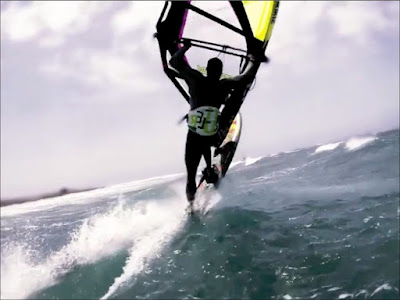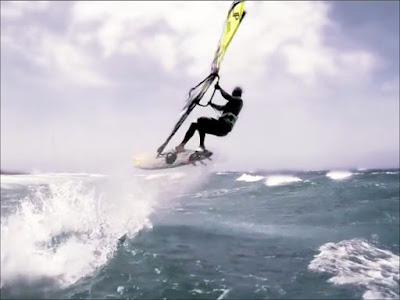Some old loop instructions were simple: "Jump high and sheet in!". That actually did work for some people. But for many others, the advice resulted in "killer loop" attempts that broke gear and bones. You'll probably have a hard time finding a professional instructor who uses this advice. Broken gear and bodies are not good business.
I've been looking at loop videos a lot recently, and noticed a few things. Let's start with a picture:
This is from a Josep Pons video that I blogged about in the past. He is setting up for the loop. Note that his body is over the board, and both arms are bent, with the elbows at roughly a 90 degree angle.
Now check the next picture:
Josep is starting to take off, but the board has not yet left the water completely. The mast has moved towards the windward-forward side, and his front arm is fully extended. The back arm is still bent, but the hand is over his head.
Mr. Pons has some of the most beautiful loops in windsurfing. Lots of PWA pros line up to get lessons from him, often to work on double loops. Imitating him seems like a good idea!
The movement of the front arm is punch-like. Just imagine a giant standing on the front-right side, and Josep trying to punch his nose! The back hand also goes up; with the giant there, I guess he's protecting his head from counter punches.
The bent front arm in the first picture means that the sail is partially de-powered: bending the front arm sheets out, the same way as extending the back arm would. In the loop, the sail must be partly sheeted out at the beginning, so that the mast can be moved to forward-windward (where it is in the second picture).
Punching up helps to lift the nose of the board for lift-off. Interestingly, extending the front arm to punch the giant's nose also exposes more of the sail to the wind - it effectively sheets in. That starts to turn the nose of the board downwind, which in turn exposes even more of the sail to the wind - I call this "automatic sheet in". This can be clearly seen if you compare picture 2 to the next picture, where the board has just left the water:
We've just punched a giant in the nose. That made the giant angry! I think it's a really good idea to make ourselves really small now, so the giant has a smaller target:
By curling up into a ball, we can rotate faster. If you've ever tried a somersault, you know that! In the process, we also pull up with the back foot, which keeps the tail of the board from going back down into the water prematurely.
If you're learning the loop and managed to first punch the giant's nose like Josep, and then curl up into a ball, you're well on the way to at least landing on your back, hopefully in a position to water start, so I won't go into what comes next - I think that's comparatively easy, if you managed to get into the position shown in the last picture above.
So, here's the really simple loop instruction:
- Before takeoff, get your body over the board. Sheet out by bending your front arm.
- As you go up the wave, punch the giant's nose. Just remember that the giant is standing on the windward-forward side of your board, and not on the nose of your board!
- Once in the air, pull up with the back leg and make yourself small. Enjoy the ride!
As I am writing this, I can't help but think back at the one time I actually fought a giant. Maybe "fought" is an overstatement - it was just point sparring at a Kempo Karate tournament. Maybe he was not really a giant, but he was at least a head taller than I was. The fight was over quickly. No, I did not manage to punch his nose - I had never before sparred with anyone who was a lot taller than I am, so I really had no clue. But the giant in the loop is imaginary, so he should be easier to hit, right? I won't say he does not hit back, though - I have had a few hard backslaps in earlier loop tries. Maybe it helps if I hit harder :-).



